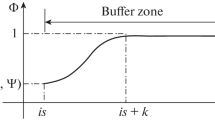Abstract
The initial model of turbulent spots with the wall disturbance using the pulse form was proposed. A group of three-dimensional coupling compact difference schemes with high accuracy and high resolution were developed, and implemented to simulate the formation and development of turbulent spots in the near-wall shear flow by means of direct numerical simulation of the Navier-Stokes equations. Growing and decaying modes were used to analyze nonlinear evolution characteristics of the turbulent spots.
Similar content being viewed by others
References
Das, A., Mathew, J., Direct numerical of turbulent spots, Computers & Fluids, 2001, 30: 532–541.
Alavyoon, F., Henningson, D. S., Alfredsson, P. H., Turbulent spots in plane Poiseuille flow visualization, Phys. Fluids, 1986, 29(4): 1328–1354.
Grek, G. R., Kozlov, V. V., Katasonov, M. M. et al., Experiment study of a Λ-structure development and its transformation into the turbulent spot, Current Science, 2000, 79(6): 781–789.
Mark, W. J., On the flow structure within a turbulent spot, Heat and Fluid flow, 2001, 22: 409–416.
Lundbladh, A., Johansson, A. V., Direct simulation of turbulent spots in plane Couette flow, J. Fluid Mech., 1991, 229: 499–516.
Gaster, M., Grant, I., An experimental investigation of the formation and development of a wave packet in laminar boundary layer, Proc. Roy. Soc., 1975, 347: 253–269.
Zhou, H., Lu, C. G., Luo, J. S., Modeling of individual coherent structures in the wall region of a turbulent boundary layer, Science in China, Ser. A, 1999, 42(6): 627–635.
Lele, S. K., Compact finite difference schemes with spectral-like resolution, J. Comput. Phys., 1992, 103: 16–42.
Moin, R., Direct simulation of turbulent flow using finite-difference schemes, J. Comput. Phys., 1991, 96: 15–53.
Karniakis, G. E., Israeli, M., Orszag, S. A. et al., High-order splitting methods for the incompressible Navier-Stokes equation, J. Comput. Phys., 1991, 97: 414–443.
Tang, D. B., Xia, H., Nonlinear evolution analysis of T-S disturbance wave at finite amplitude in nonparallel boundary layers, Applied Mathematics and Mechanics, 2002, 23(6): 660–669.
Wang, W. Z., Tang, D. B., Studies on nonlinear stability of three-dimensional H-type disturbance, Acta Mechanica Sinica, 2003, 19(6): 517–526.
Author information
Authors and Affiliations
Corresponding author
Rights and permissions
About this article
Cite this article
Zhang, L., Tang, D. Nonlinear evolution of turbulent spots in the near-wall shear flow. SCI CHINA SER G 49, 158–168 (2006). https://doi.org/10.1007/s11433-006-0158-4
Received:
Accepted:
Published:
Issue Date:
DOI: https://doi.org/10.1007/s11433-006-0158-4




